Planning a trip to Southeast Asia’s dynamic duo – Malaysia and Singapore? You’re in for a treat! But timing your visit can make or break your experience in these neighboring yet distinctly different destinations. While they may be geographically close, Malaysia and Singapore present unique climate patterns, cultural events, and travel experiences throughout the year.
This comprehensive guide tackles the complex challenge of finding the best time to visit Malaysia and Singapore together. Rather than treating them as separate destinations, we’ll provide a side-by-side comparison for each month, helping you identify the perfect window for your combined adventure.
Quick Summary: February through April offers the best overall balance for visiting both countries, with lower rainfall and comfortable temperatures. September-October provides another good window, though with a slight risk of haze in Singapore. November through January are excellent for Singapore but problematic for Malaysia’s east coast beaches. May through August works well for comprehensive Malaysia exploration but can be hotter in Singapore.
Table of Contents
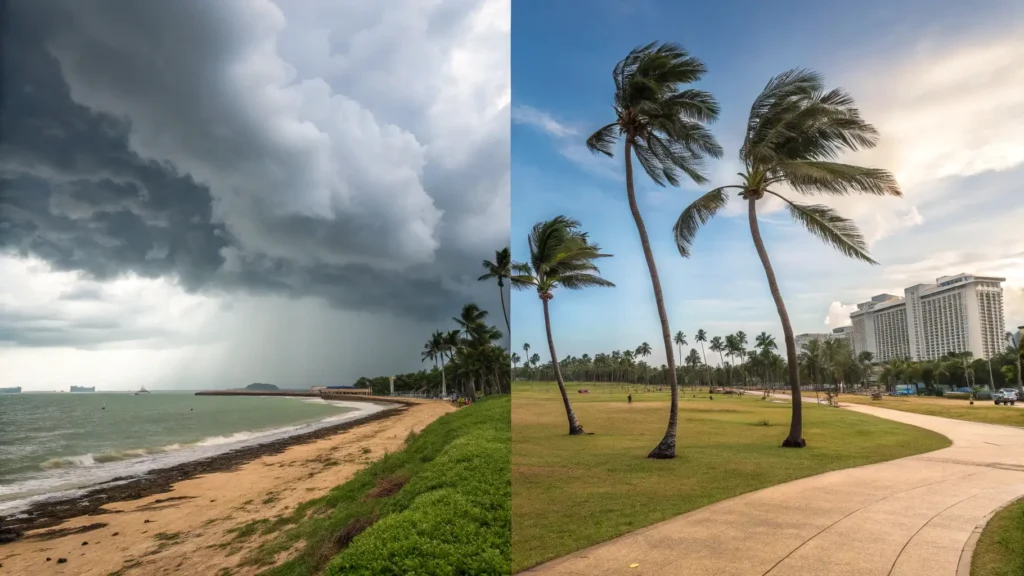
Malaysia vs. Singapore: Key Climate Differences at a Glance
Before diving into monthly details, let’s understand the fundamental climate differences between these neighboring nations:
| Factor | Malaysia | Singapore |
|---|---|---|
| Climate Type | Tropical with distinct regional variations | Tropical with more uniform conditions |
| Monsoon Patterns | Northeast Monsoon (Nov-Mar) affects east coast severely; Southwest Monsoon (May-Sep) brings less rain to west | Northeast Monsoon (Nov-Jan) brings heaviest rain; Southwest Monsoon (May-Sep) is relatively drier |
| Regional Variations | Significant differences between West Coast, East Coast, and Borneo | Minimal variation across the small island nation |
| Temperature Range | 23-33°C (73-91°F) year-round | 25-32°C (77-90°F) year-round |
| Humidity | High (70-90%) | Very high (70-95%) |
Malaysia experiences greater climatic diversity due to its larger landmass spanning both sides of the South China Sea. The east coast faces severe monsoon conditions that can shut down beach destinations entirely, while the west coast remains more accessible year-round. Singapore, being smaller, experiences more consistent conditions but still has distinct wetter and drier periods. “best time to visit malaysia and singapore”
Both countries are affected by the Northeast Monsoon (bringing heavy rain) and Southwest Monsoon (generally drier), but the timing and intensity vary significantly.
Month-by-Month Comparative Breakdown: Malaysia & Singapore

January
Malaysia Overview:
- West Coast: Relatively dry and sunny with occasional showers (26-32°C/79-90°F)
- East Coast: Heavy rainfall, rough seas, many resorts closed
- Borneo: Rainy season in Sabah and Sarawak (heavy downpours)
- Events: Thai Pongal, Chinese New Year (if it falls in January)
- Pros: Lower crowds on west coast, good deals on accommodation
- Cons: East coast beaches largely inaccessible, outdoor activities limited in Borneo
Singapore Overview:
- Weather: Tail end of the Northeast Monsoon (24-30°C/75-86°F)
- Rainfall: Still wet with frequent afternoon showers (average 238mm)
- Events: Art Week, potentially Chinese New Year
- Pros: Post-holiday period means fewer tourists
- Cons: Higher humidity and rainfall can affect outdoor sightseeing
Combined Verdict for January: Good for city exploration in Singapore and west coast Malaysia (KL, Penang, Malacca). Avoid east coast beaches entirely. Plan indoor activities and keep flexible itineraries to work around rain showers. Not ideal for a beach-focused holiday.
February
Malaysia Overview:
- West Coast: Dry and sunny with minimal rainfall (26-33°C/79-91°F)
- East Coast: Transitional period, rain decreasing but seas still rough
- Borneo: Rainfall decreasing in Sabah; Sarawak still wet
- Events: Chinese New Year (if it falls in February), Federal Territory Day
- Pros: Excellent weather in west coast destinations
- Cons: Chinese New Year can bring crowds and price hikes; east coast beaches still limited
Singapore Overview:
- Weather: Transitioning to drier period (25-31°C/77-88°F)
- Rainfall: Decreasing (average 165mm)
- Events: Chinese New Year (if it falls in February), Chingay Parade
- Pros: Increasingly pleasant weather, less rain than January
- Cons: Chinese New Year period brings crowds and higher prices
Combined Verdict for February: Very good month for a combined trip, particularly for urban exploration. Excellent time to visit Singapore and west coast Malaysia. If Chinese New Year falls in February, expect festive atmosphere but also crowds and price increases. East coast beaches in Malaysia begin opening but aren’t at their best yet.
March
Malaysia Overview:
- West Coast: Dry and hot with minimal rainfall (27-33°C/81-91°F)
- East Coast: Weather improves significantly, beaches reopen
- Borneo: Drier conditions emerging, good for rainforest exploration
- Events: LIMA (Langkawi International Maritime & Aerospace Exhibition, biennial)
- Pros: Excellent overall weather across most regions
- Cons: Beginning to get hot in major cities
Singapore Overview:
- Weather: Dry and hot (26-32°C/79-90°F)
- Rainfall: Low (average 154mm)
- Events: Singapore Design Week, World Gourmet Summit
- Pros: Excellent weather with minimal rain interruptions
- Cons: Can be hot for extended outdoor activities
Combined Verdict for March: One of the best months for a comprehensive Malaysia-Singapore trip. All major regions are accessible with favorable weather. East coast beaches are becoming viable, while Singapore and west coast Malaysia offer sunny, mostly dry conditions. Ideal for travelers wanting variety including beaches, cities, and nature.
April
Malaysia Overview:
- West Coast: Hot and mainly dry with increasing showers (27-33°C/81-91°F)
- East Coast: Excellent conditions with calm seas and sunny days
- Borneo: Good weather for wildlife spotting and mountain climbing
- Events: Songkran/Water Festival in northern states
- Pros: Peak conditions for east coast islands, good overall weather
- Cons: Very hot in urban areas, occasional thunderstorms
Singapore Overview:
- Weather: Hot but relatively dry (26-32°C/79-90°F)
- Rainfall: Moderate increase (average 166mm)
- Events: Singapore International Film Festival
- Pros: Generally good weather with manageable rain
- Cons: Heat can be intense for outdoor sightseeing
Combined Verdict for April: Excellent month for a comprehensive trip. Perfect timing for Malaysia’s east coast beaches while Singapore and west coast Malaysia remain highly accessible. The heat can be intense in urban areas, so plan outdoor activities for early morning or evening. Good balance of weather across all regions makes this one of the best months for experiencing everything.
May
Malaysia Overview:
- West Coast: Hot with increasing rainfall (27-33°C/81-91°F)
- East Coast: Excellent beach weather, clear waters for diving
- Borneo: Good conditions before heavy rains return
- Events: Harvest Festival in Sabah, Wesak Day celebrations
- Pros: Ideal conditions for east coast islands and diving
- Cons: Increasing rainfall in west coast and KL
Singapore Overview:
- Weather: Start of Southwest Monsoon, hot (26-32°C/79-90°F)
- Rainfall: Moderate (average 171mm) with brief thunderstorms
- Events: Singapore Arts Festival, Great Singapore Sale begins
- Pros: Thunderstorms typically brief and predictable
- Cons: Potential early haze issues (depending on Indonesia)
Combined Verdict for May: Good month overall, particularly excellent for east coast Malaysia beaches. Singapore experiences intermittent thunderstorms but they’re usually brief. Slight risk of early haze in Singapore. Good for combining Singapore city exploration with Malaysia’s beautiful east coast islands like Perhentian, Redang, or Tioman.
June
Malaysia Overview:
- West Coast: Southwest Monsoon brings intermittent rainfall (27-32°C/81-90°F)
- East Coast: Peak season with excellent weather and visibility
- Borneo: Variable conditions; Gawai Dayak festival in Sarawak
- Events: Gawai Dayak (Sarawak), school holidays (mid-May to mid-June)
- Pros: Perfect east coast beach conditions
- Cons: School holidays mean domestic tourism peaks
Singapore Overview:
- Weather: Southwest Monsoon, hot with brief afternoon showers (27-32°C/81-90°F)
- Rainfall: Moderate (average 163mm)
- Events: Great Singapore Sale, Dragon Boat Festival
- Pros: Good shopping deals during GSS
- Cons: Potential haze from Indonesian forest fires
Combined Verdict for June: Good month for east coast Malaysia beach destinations combined with Singapore shopping during the Great Singapore Sale. Watch weather forecasts for potential haze in Singapore. Borneo is variable but workable. School holidays mean more domestic tourists at popular destinations.
July
Malaysia Overview:
- West Coast: Frequent short showers but plenty of sunshine (26-32°C/79-90°F)
- East Coast: Excellent beach conditions continue
- Borneo: Mixed conditions, but generally good for wildlife
- Events: George Town Festival (Penang)
- Pros: East coast beaches at their best
- Cons: Can be busy with European summer vacationers
Singapore Overview:
- Weather: Typically drier period of Southwest Monsoon (27-32°C/81-90°F)
- Rainfall: Lower (average 150mm)
- Events: Singapore Food Festival, Great Singapore Sale continues
- Pros: Relatively dry with good outdoor conditions
- Cons: Higher chance of haze from Indonesian fires
Combined Verdict for July: Good month for a combined trip, particularly for east coast Malaysia beaches paired with Singapore urban experiences. July typically has less rainfall in Singapore. Monitor haze conditions for Singapore, which can vary significantly year to year. Popular with international tourists so book accommodation in advance.
August
Malaysia Overview:
- West Coast: Intermittent showers but generally good conditions (26-32°C/79-90°F)
- East Coast: Continued excellent beach weather
- Borneo: Variable rainfall but generally favorable
- Events: Merdeka (Independence) preparations, cultural festivals
- Pros: Generally good conditions across most regions
- Cons: European holiday season means higher visitor numbers
Singapore Overview:
- Weather: Typically drier with occasional showers (27-32°C/81-90°F)
- Rainfall: Moderate (average 148mm)
- Events: National Day (August 9), Night Festival
- Pros: Festive atmosphere around National Day
- Cons: Haze potential remains; crowded during National Day celebrations
Combined Verdict for August: Good overall month with balanced conditions throughout both countries. East coast Malaysia beaches remain excellent while Singapore’s National Day brings festivities and spectacular fireworks. Haze risk exists for Singapore but is highly variable year to year. Book accommodation well in advance, especially around Singapore’s National Day.
September
Malaysia Overview:
- West Coast: Improving weather with decreasing rainfall (26-32°C/79-90°F)
- East Coast: Last month of ideal conditions before transition
- Borneo: Generally good conditions for wildlife viewing
- Events: Malaysia Day (September 16), Mid-Autumn Festival
- Pros: Good balance of weather across regions
- Cons: East coast begins transitioning late month
Singapore Overview:
- Weather: Typically drier with lower rainfall (26-32°C/79-90°F)
- Rainfall: Lower (average 156mm)
- Events: Formula 1 Singapore Grand Prix, Mid-Autumn Festival
- Pros: Good overall conditions, exciting F1 atmosphere
- Cons: F1 period brings crowds and price hikes; haze potential
Combined Verdict for September: Excellent month for a balanced trip with good conditions throughout both countries. Last chance to enjoy east coast Malaysia beaches before the monsoon transition begins. Singapore hosts the exciting F1 Night Race (book accommodations far in advance if visiting during this period). Monitor haze conditions which can affect Singapore.
October
Malaysia Overview:
- West Coast: Transitional month with increasing rainfall (26-31°C/79-88°F)
- East Coast: Weather begins changing with more frequent rain
- Borneo: Increasing rainfall, especially in Sarawak
- Events: Deepavali/Diwali celebrations
- Pros: Lower crowds as peak season winds down
- Cons: East coast beach conditions deteriorate late month
Singapore Overview:
- Weather: Inter-monsoon period brings increased rainfall (26-31°C/79-88°F)
- Rainfall: Increasing (average 154mm)
- Events: Deepavali preparations, arts events
- Pros: Haze typically diminishes
- Cons: More unpredictable rainfall patterns
Combined Verdict for October: Good transitional month, particularly early October which can still offer good conditions across both countries. Visit east coast Malaysia beaches early in the month before conditions deteriorate. Singapore sees increasing but usually manageable rainfall. Good for cultural experiences with Deepavali preparations.
November
Malaysia Overview:
- West Coast: Increasing rainfall as Northeast Monsoon approaches (25-31°C/77-88°F)
- East Coast: Northeast Monsoon begins, heavy rain, rough seas
- Borneo: Heavy rainfall, especially in Sarawak
- Events: Deepavali (if it falls in November)
- Pros: Lower tourist numbers means better deals
- Cons: East coast beach destinations begin closing
Singapore Overview:
- Weather: Start of Northeast Monsoon (25-31°C/77-88°F)
- Rainfall: High (average 258mm)
- Events: Christmas preparations begin, Singapore Biennale
- Pros: Festive atmosphere emerges
- Cons: Frequent heavy downpours, though usually short-lived
Combined Verdict for November: Good for Singapore and west coast Malaysia, but avoid east coast beach destinations. Rain in Singapore and west coast Malaysia tends to come in heavy but brief downpours, leaving plenty of time for sightseeing. Consider more indoor activities and have flexible plans. Good month for cultural experiences and food exploration while avoiding crowds.
December
Malaysia Overview:
- West Coast: Northeast Monsoon brings heavy but usually brief showers (25-31°C/77-88°F)
- East Coast: Heavy rains, rough seas, many resorts closed
- Borneo: Rainy season in full effect
- Events: Christmas, New Year celebrations, school holidays
- Pros: Festive atmosphere in major cities
- Cons: East coast beaches largely inaccessible; domestic tourism peaks
Singapore Overview:
- Weather: Northeast Monsoon peak (25-30°C/77-86°F)
- Rainfall: Highest of the year (average 318mm)
- Events: Christmas, New Year celebrations, Orchard Road lights
- Pros: Spectacular Christmas decorations and festivities
- Cons: Heavy rainfall can disrupt outdoor plans; peak tourist season
Combined Verdict for December: Mixed conditions but festive atmosphere. Focus on Singapore and west coast Malaysia while completely avoiding east coast beaches. Despite being the rainiest month in Singapore, the rain typically comes in heavy downpours rather than all-day precipitation. Christmas and New Year periods bring higher prices and crowds. Good for urban exploration, shopping, and cultural experiences despite the rain.
Deep Dive: Best Time to Visit Malaysia (Regional Breakdown)
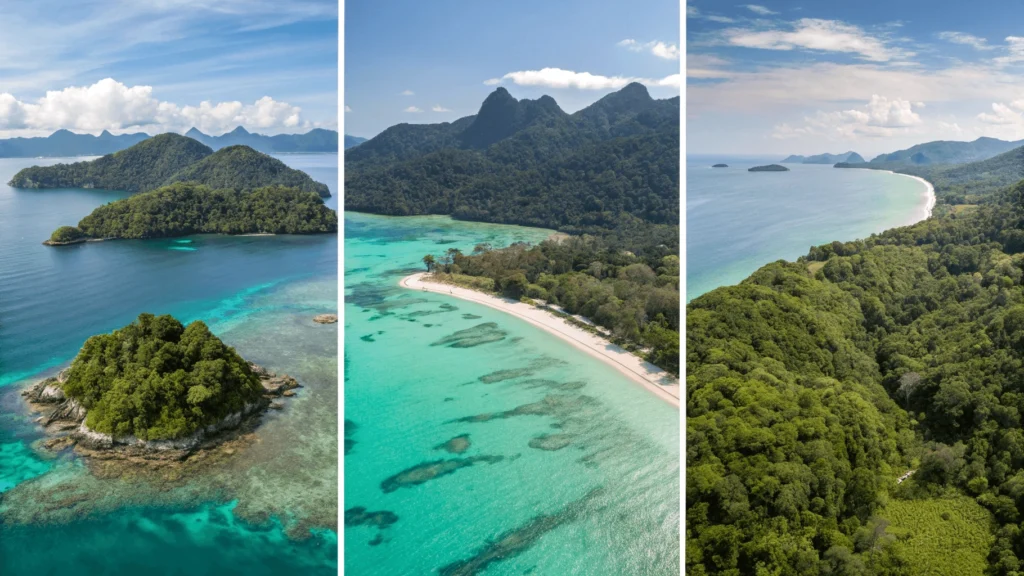
West Coast Malaysia (KL, Penang, Langkawi)
The west coast of Peninsular Malaysia includes popular destinations like Kuala Lumpur, Penang, Malacca, and Langkawi. This region experiences less severe monsoon effects than the east coast.
- Best Months: January to March, June to September
- Shoulder Season: April-May, October
- Monsoon Impact: Southwest Monsoon (May-September) brings scattered showers but rarely disrupts travel
- Recommended Activities by Season:
- Dry Season (Dec-Mar): City exploration, highlands visits, island hopping
- Wetter Season (Apr-Nov): Cultural experiences, food tours, shopping
Destination Highlights:
- Kuala Lumpur: Vibrant year-round, but February-March and June-August offer better outdoor exploration weather
- Penang: January-March provides the best balance of dry weather without excessive heat
- Langkawi: January-April offers ideal beach conditions with clear waters
East Coast Malaysia (Perhentians, Tioman, Redang)
Malaysia’s east coast offers stunning beaches and world-class diving but experiences a severe Northeast Monsoon that effectively shuts down tourism for several months.
- Best Months: March to October (peak: June to August)
- Closed Season: November to late February/early March
- Monsoon Impact: Northeast Monsoon (November-March) brings heavy rain, rough seas, and resort closures
- Recommended Activities by Season:
- Peak Season (Jun-Aug): Diving, snorkeling, beach activities
- Shoulder Season (Mar-May, Sep-Oct): More peaceful beach experience, diving with potential weather variations
Important Note: Many resorts on islands like Perhentian, Redang, and Tioman close completely during the monsoon season, with boat services suspended due to dangerous sea conditions. Some mainland destinations like Kota Bharu remain accessible but experience heavy rainfall.
Malaysian Borneo (Sabah & Sarawak)
Malaysian Borneo offers incredible wildlife experiences, diverse indigenous cultures, and Mount Kinabalu, but has distinct climate patterns from Peninsular Malaysia.
- Best Months for Sabah: April to October
- Best Months for Sarawak: March to October (slightly wetter than Sabah)
- Wettest Period: November to February
- Wildlife Viewing:
- Orangutans: Year-round in rehabilitation centers; April-October best for wild sightings
- Turtles (Sabah): July-October for hatching
- Proboscis Monkeys: Year-round with better visibility in drier months
- Mount Kinabalu Climbing: April-August offers the most reliable conditions
Deep Dive: Best Time to Visit Singapore
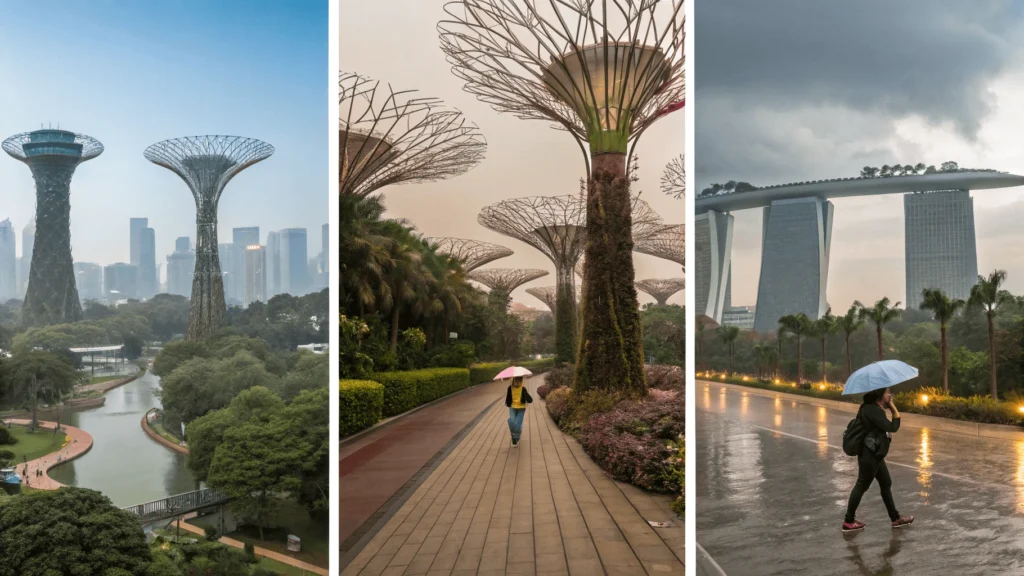
Despite its small size, Singapore’s weather patterns significantly impact the visitor experience throughout the year.
Northeast Monsoon (November-January)
- Rainfall: Heaviest of the year (250-318mm monthly)
- Characteristics: Short but intense downpours, often in the afternoon
- Temperature: Slightly cooler (24-30°C/75-86°F)
- Best For: Museum visits, shopping, dining, indoor attractions
- Challenges: Outdoor activities may require flexible scheduling
Inter-monsoon Periods (April & October)
- Rainfall: Moderate but unpredictable (154-166mm monthly)
- Characteristics: Thunderstorms and heavy showers with less predictable patterns
- Temperature: Hot and humid (26-32°C/79-90°F)
- Best For: Mixed itineraries with indoor and outdoor activities
- Challenges: Weather unpredictability requires flexible planning
Southwest Monsoon (May-September)
- Rainfall: Lower but still present (148-171mm monthly)
- Characteristics: Hot with brief afternoon thunderstorms
- Temperature: Hot (26-32°C/79-90°F)
- Best For: Outdoor exploration, parks, gardens
- Challenges: Potential haze from Indonesian forest fires (especially June-September)
Haze Risk (June-October)
Singapore periodically experiences haze from Indonesian forest fires, most commonly during the Southwest Monsoon. The severity varies dramatically year to year:
- Worst Recent Episodes: 2013, 2015, 2019
- Impact: Reduced visibility, air quality concerns, outdoor activity limitations
- Monitoring: Check PSI (Pollutant Standards Index) readings when planning travel during these months
Major Events Impact
- Chinese New Year (Jan/Feb): Businesses may close for several days; spectacular decorations but potential disruptions
- Great Singapore Sale (Jun-Aug): Shopping discounts but increased visitor numbers
- F1 Grand Prix (September): Exciting atmosphere but significantly higher hotel rates and crowds
- Christmas/New Year (December): Festive atmosphere but peak season pricing
Best Time Based on Your Travel Style & Activities
For Beach Lovers & Divers
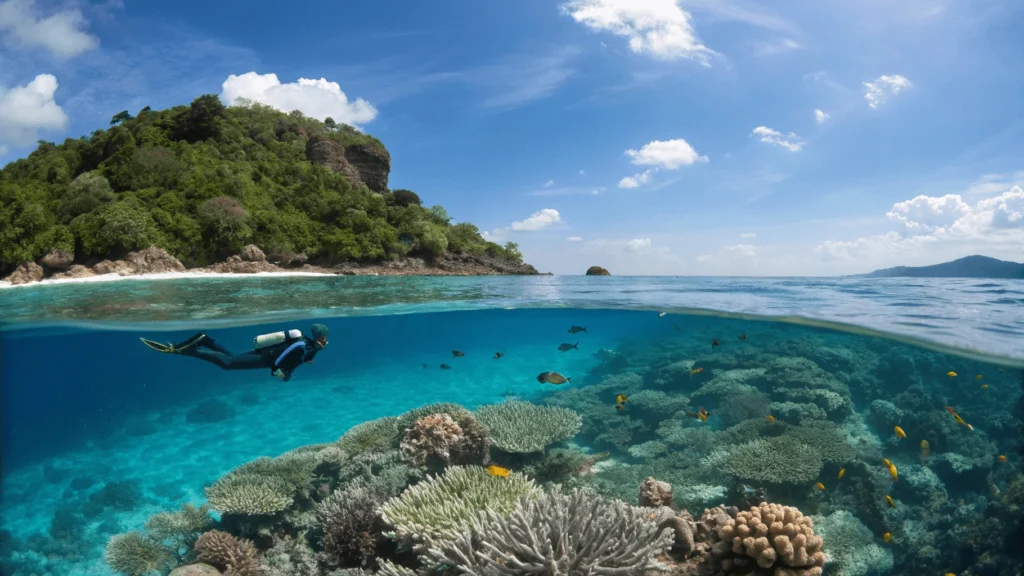
- Optimal Window: March to October
- Prime Period: June to August offers the best overall conditions for Malaysia’s east coast beaches with calm seas and excellent visibility for diving
- Important Notes:
- East coast Malaysia beaches are essentially closed November through February
- Singapore’s beaches (Sentosa) are secondary attractions and accessible year-round
- Langkawi (west coast) has different optimal times (November-April) than east coast islands
Recommended Strategy: Plan beach-focused trips for June-August to enjoy Malaysia’s stunning east coast islands. For a mixed city-beach experience during other months, combine Singapore with Langkawi or other west coast locations.
For City Explorers & Culture Vultures
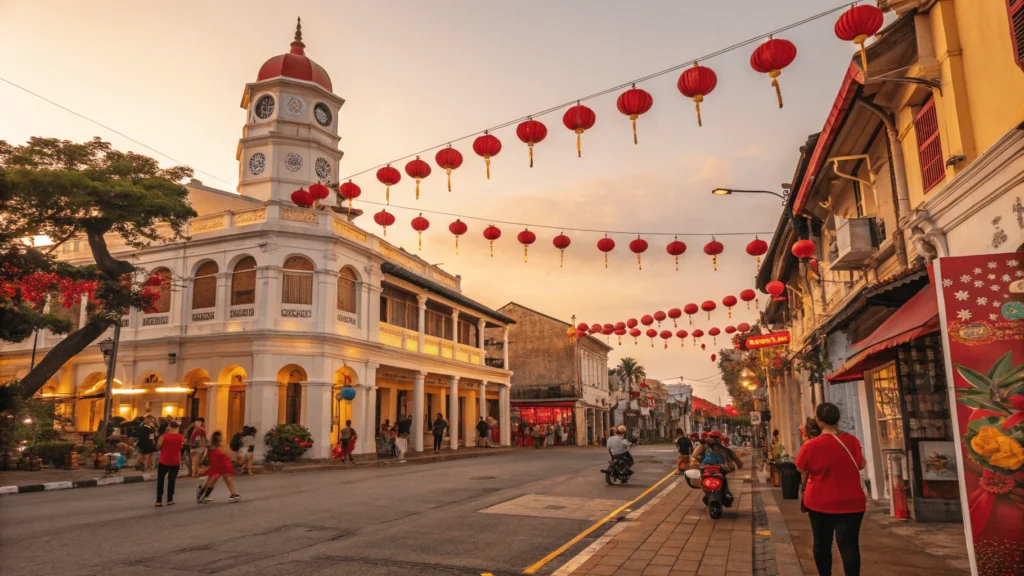
- Optimal Window: Year-round with modifications
- Best Overall Months: February-March, July-September
- Festival Considerations:
- Chinese New Year (Jan/Feb): Spectacular but some businesses close; higher prices
- Ramadan/Hari Raya: Possible reduced hours for some businesses in Malaysia
- Deepavali: Colorful celebrations in both countries’ Indian districts
Recommended Strategy: City exploration works year-round but adapt to rainfall patterns. In wetter months (November-January), plan indoor activities during afternoon downpour hours. February-March and July-September offer the best balance for outdoor city exploration.
For Budget Travelers
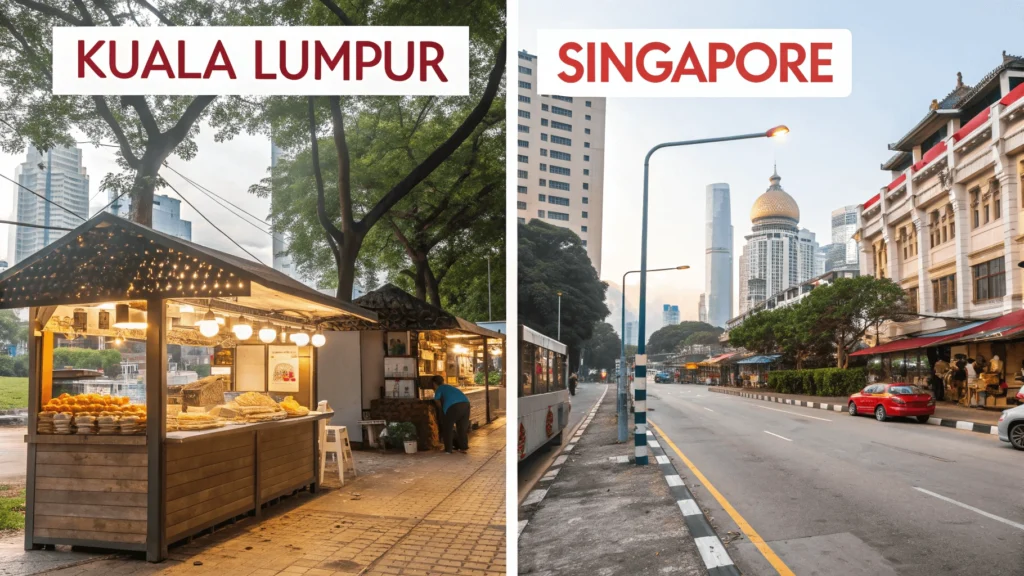
- Lowest Prices in Malaysia:
- East Coast: Shoulder seasons (March-May, September-October)
- West Coast: Wetter months (September-November)
- Borneo: February-March, October-November
- Lowest Prices in Singapore:
- January (post-holiday period)
- Mid-October to November (excluding F1 period)
Recommended Strategy: March-April and September-October offer the best weather-to-price ratio across both countries. Avoid December holidays, Chinese New Year, and Singapore’s F1 period for the best deals.
To Avoid Crowds
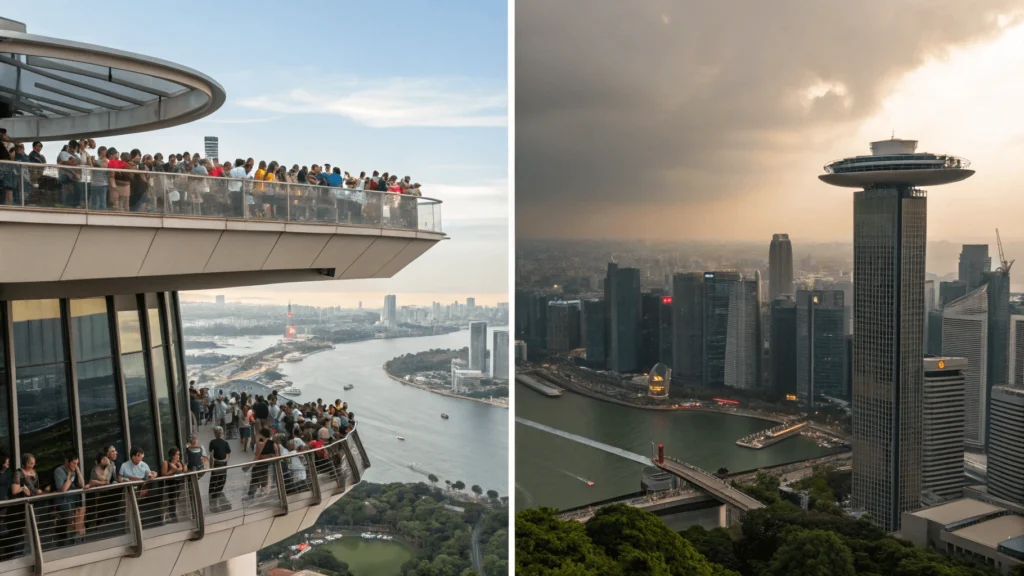
- Avoid these Peak Periods:
- School holidays (mid-November to early January, late May to mid-June)
- Chinese New Year (January/February)
- Singapore F1 Grand Prix (September)
- Great Singapore Sale peak (June-July)
- Best Times for Lower Crowds:
- Mid-January to early February (post-holiday, pre-Chinese New Year)
- Late April to early May
- Late September to early October (except during F1 in Singapore)
Recommended Strategy: Target shoulder seasons just before or after major holidays and school breaks. January (after New Year) and April-May often offer excellent weather with lower visitor numbers.
Practical Considerations for Planning Your Trip
Managing Crowds and Major Holidays

Both Malaysia and Singapore experience significant crowd fluctuations around major holidays:
- Chinese New Year (January/February): Expect business closures for 2-3 days, especially in Chinese-majority areas. Advance booking essential.
- School Holidays:
- Mid-November to early January
- Late May to mid-June
- Mid-August to early September
- Ramadan/Hari Raya: Some food establishments in Malaysia have limited daytime hours during Ramadan. Hari Raya sees domestic travel peaks.
- National Holidays: Singapore National Day (August 9), Malaysia Independence Day (August 31), Malaysia Day (September 16)
Tip: Book accommodations 3-6 months in advance if traveling during these periods.
Cost Variations by Season

Understanding price fluctuations can help budget-conscious travelers:
| Season | Malaysia | Singapore |
|---|---|---|
| Peak (Dec-Jan, Jun-Aug) | 30-50% higher hotel rates, especially beach destinations | 20-40% higher hotel rates, especially Dec-Jan |
| Shoulder (Feb-Mar, Sep-Oct) | Good value with modest premiums | Best value period (except during F1) |
| Low (Apr-May, Nov) | Best values except for east coast beaches | Lower rates except during major events |
| Event Premiums | Chinese New Year, school holidays | F1 Grand Prix (80-200% premium), NYE, CNY |
Budget-Saving Tip: Consider splitting your stay between higher-end accommodations in Malaysia (where luxury is more affordable) and mid-range options in Singapore (where even budget accommodations are relatively expensive).
Packing Essentials
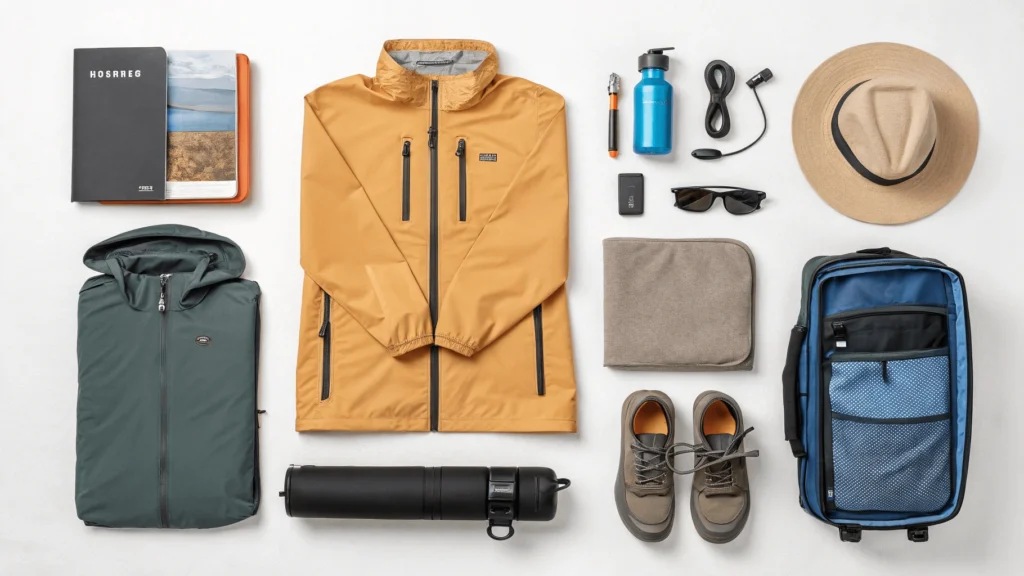
Weather-appropriate packing is essential for comfort in the tropical climate:
- Year-round Essentials:
- Lightweight, breathable clothing
- Sun protection (hat, sunglasses, high-SPF sunscreen)
- Insect repellent
- Modest attire for temple/mosque visits
- Monsoon Period Additions:
- Compact umbrella or lightweight rain jacket
- Quick-dry clothing
- Waterproof phone case
- Water-resistant footwear
- Specialty Items:
- Hiking boots for Borneo or mountain activities
- Conservative swimwear for Malaysia’s more traditional beaches
- Layer for intense air-conditioning in malls/indoor venues
Frequently Asked Questions (FAQ)
What is the rainiest month in Malaysia and Singapore?
In Singapore, December has the highest average rainfall (318mm), while Malaysia’s rainiest periods vary by region: November-January for the east coast, April-May and September-October for the west coast, and November-January for Borneo.
Can I visit Malaysia and Singapore during Ramadan/Hari Raya?
Yes, you can visit during Ramadan, but be aware that in Malaysia (particularly in more conservative states), some restaurants may be closed during daylight hours. Tourist areas and hotels maintain normal operations. Singapore sees minimal disruption. Hari Raya (Eid) celebrations are vibrant and interesting to experience but come with increased domestic travel and some business closures.
Is it cheaper to visit Malaysia or Singapore?
Malaysia is significantly less expensive than Singapore across all categories including accommodation (50-70% cheaper), food (60-80% cheaper), and transportation (40-60% cheaper). Budget travelers can enjoy Malaysia for approximately $30-50 USD daily, while Singapore typically requires $100-150 USD daily minimum.
What’s the absolute worst time to visit Malaysia and Singapore?
The worst combined time would be December-January if you’re interested in comprehensive exploration including east coast beaches. This period combines peak season prices, heavy rainfall in Singapore, closure of east coast beach destinations, and holiday crowds. For general urban exploration only, there’s no “terrible” time, as both countries are accessible year-round.
How many days do I need for Malaysia and Singapore?
For a combined trip:
Minimum viable trip: 7 days (3 in Singapore, 4 in one Malaysia region)
Balanced exploration: 14 days (4 in Singapore, 10 across 2-3 Malaysian regions)
Comprehensive experience: 21+ days to include Peninsular Malaysia and Borneo
Your timing will affect this calculation – during optimal weather windows (February-April, September-October), you can explore more efficiently.
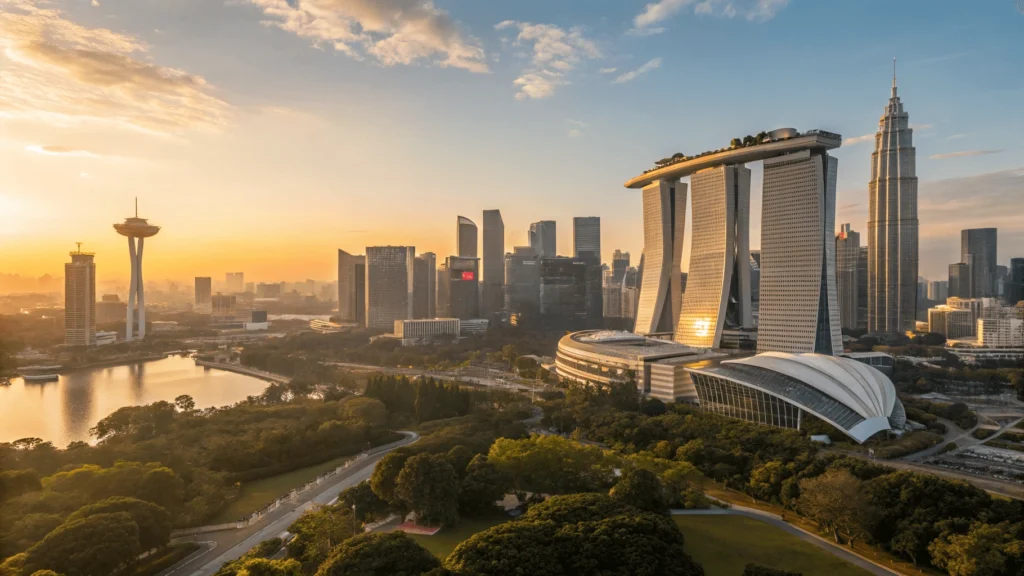
Conclusion
The best time to visit Malaysia and Singapore together depends primarily on what you want to experience:
- For the best overall experience combining all regions: February to April offers the optimal balance of weather conditions across both countries.
- For beach lovers prioritizing Malaysia’s stunning east coast islands: June to August provides ideal conditions, though Singapore will be hot with occasional thunderstorms.
- For city exploration with minimal rain: February-March provides excellent conditions for urban adventures in both countries.
- For budget travelers seeking good weather and lower prices: March-April and September-October offer the best compromise between favorable conditions and reduced costs.
Remember that both countries offer incredible experiences year-round – even during monsoon seasons, rain typically comes in predictable patterns leaving plenty of time for exploration. By understanding the regional weather patterns and aligning them with your travel priorities, you can create the perfect Malaysia-Singapore adventure any time of year.
Ready to plan your Southeast Asian adventure? Check out our detailed Malaysia itinerary guide or our Singapore neighborhood breakdown to continue crafting your perfect trip!


